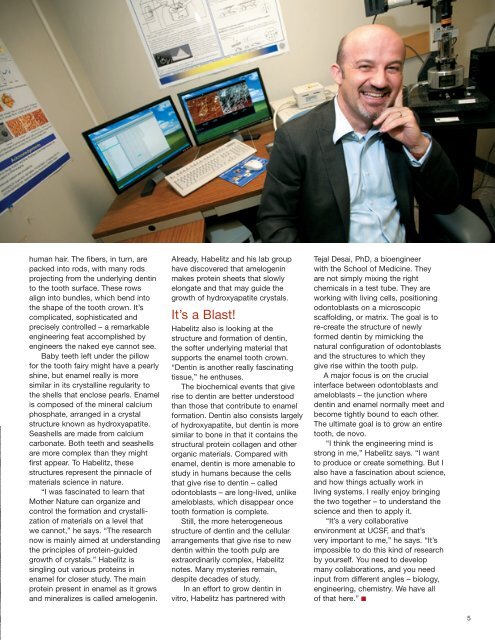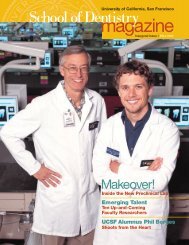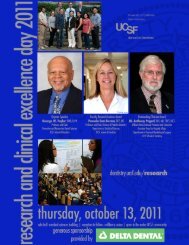2010 - UCSF School of Dentistry - University of California, San ...
2010 - UCSF School of Dentistry - University of California, San ...
2010 - UCSF School of Dentistry - University of California, San ...
You also want an ePaper? Increase the reach of your titles
YUMPU automatically turns print PDFs into web optimized ePapers that Google loves.
human hair. The fibers, in turn, are<br />
packed into rods, with many rods<br />
projecting from the underlying dentin<br />
to the tooth surface. These rows<br />
align into bundles, which bend into<br />
the shape <strong>of</strong> the tooth crown. It’s<br />
complicated, sophisticated and<br />
precisely controlled – a remarkable<br />
engineering feat accomplished by<br />
engineers the naked eye cannot see.<br />
Baby teeth left under the pillow<br />
for the tooth fairy might have a pearly<br />
shine, but enamel really is more<br />
similar in its crystalline regularity to<br />
the shells that enclose pearls. Enamel<br />
is composed <strong>of</strong> the mineral calcium<br />
phosphate, arranged in a crystal<br />
structure known as hydroxyapatite.<br />
Seashells are made from calcium<br />
carbonate. Both teeth and seashells<br />
are more complex than they might<br />
first appear. To Habelitz, these<br />
structures represent the pinnacle <strong>of</strong><br />
materials science in nature.<br />
“I was fascinated to learn that<br />
Mother Nature can organize and<br />
control the formation and crystallization<br />
<strong>of</strong> materials on a level that<br />
we cannot,” he says. “The research<br />
now is mainly aimed at understanding<br />
the principles <strong>of</strong> protein-guided<br />
growth <strong>of</strong> crystals.” Habelitz is<br />
singling out various proteins in<br />
enamel for closer study. The main<br />
protein present in enamel as it grows<br />
and mineralizes is called amelogenin.<br />
Already, Habelitz and his lab group<br />
have discovered that amelogenin<br />
makes protein sheets that slowly<br />
elongate and that may guide the<br />
growth <strong>of</strong> hydroxyapatite crystals.<br />
It’s a Blast!<br />
Habelitz also is looking at the<br />
structure and formation <strong>of</strong> dentin,<br />
the s<strong>of</strong>ter underlying material that<br />
supports the enamel tooth crown.<br />
“Dentin is another really fascinating<br />
tissue,” he enthuses.<br />
The biochemical events that give<br />
rise to dentin are better understood<br />
than those that contribute to enamel<br />
formation. Dentin also consists largely<br />
<strong>of</strong> hydroxyapatite, but dentin is more<br />
similar to bone in that it contains the<br />
structural protein collagen and other<br />
organic materials. Compared with<br />
enamel, dentin is more amenable to<br />
study in humans because the cells<br />
that give rise to dentin – called<br />
odontoblasts – are long-lived, unlike<br />
ameloblasts, which disappear once<br />
tooth formation is complete.<br />
Still, the more heterogeneous<br />
structure <strong>of</strong> dentin and the cellular<br />
arrangements that give rise to new<br />
dentin within the tooth pulp are<br />
extraordinarily complex, Habelitz<br />
notes. Many mysteries remain,<br />
despite decades <strong>of</strong> study.<br />
In an effort to grow dentin in<br />
vitro, Habelitz has partnered with<br />
Tejal Desai, PhD, a bioengineer<br />
with the <strong>School</strong> <strong>of</strong> Medicine. They<br />
are not simply mixing the right<br />
chemicals in a test tube. They are<br />
working with living cells, positioning<br />
odontoblasts on a microscopic<br />
scaffolding, or matrix. The goal is to<br />
re-create the structure <strong>of</strong> newly<br />
formed dentin by mimicking the<br />
natural configuration <strong>of</strong> odontoblasts<br />
and the structures to which they<br />
give rise within the tooth pulp.<br />
A major focus is on the crucial<br />
interface between odontoblasts and<br />
ameloblasts – the junction where<br />
dentin and enamel normally meet and<br />
become tightly bound to each other.<br />
The ultimate goal is to grow an entire<br />
tooth, de novo.<br />
“I think the engineering mind is<br />
strong in me,” Habelitz says. “I want<br />
to produce or create something. But I<br />
also have a fascination about science,<br />
and how things actually work in<br />
living systems. I really enjoy bringing<br />
the two together – to understand the<br />
science and then to apply it.<br />
“It’s a very collaborative<br />
environment at <strong>UCSF</strong>, and that’s<br />
very important to me,” he says. “It’s<br />
impossible to do this kind <strong>of</strong> research<br />
by yourself. You need to develop<br />
many collaborations, and you need<br />
input from different angles – biology,<br />
engineering, chemistry. We have all<br />
<strong>of</strong> that here.” n<br />
5




